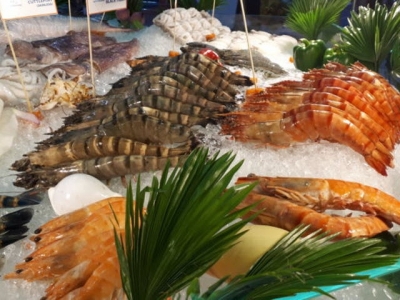Bangladesh shrimp farmers stick to black tiger, for now

Vietnamese black tiger shrimp as displayed by Mekong Seafood Connection By Haider Mahabubul, additional reporting by Neil Ramsden
Bangladesh is keeping its focus on black tiger shrimp production, even as its neighbor, India, aims to farm 1 million metric tons of vannamei.
Although the country has carved out a niche in black tiger, this can be developed further, a leading industry figure told Undercurrent News. Bangladesh would likely have to produce vannamei in the future, in order to remain globally competitive, he said.
Currently -- according to Moin Uddin Ahmed, team leader at the sustainable and inclusive shrimp business promotion project of the international network organization Solidaridad -- the Bangladeshi government has not yet given permission to produce vannamei.
In 2012 Undercurrent wrote that the government was planning to allow it, with the country's frozen food exporters arguing their black tiger production could not compete globally with the higher-yield and more affordable vannamei exports of neighbors; seemingly this has not yet come to pass.
Following the Seafood Expo Global in Brussels one industry news outlet reported that UK-based Seamark had permission to begin farming vannamei in Bangladesh, from which it sources already.
However, Selim Reza Hasann, country manager with Solidaridad Network Asia, told Undercurrent he had met with the Bangladeshi government, which confirmed this story to be untrue.
"The government is in favor of black tiger shrimp, and they will undertake feasibility before taking any decision," he said. Nahid Iqbal with Seamark also confirmed to Undercurrent that the article was inaccurate:
"Seamark is in the process of introducing vannamei farming in Bangladesh, and as regulations become more relaxed, there will be potential to embark on vannamei farming in Bangladesh. The article I believe has since been altered."
Toying with the idea
Md Tariqul Islam Zaheer, managing director of Achia Sea Foods and also a director of the Bangladesh Frozen Foods Exporters Association (BFFEA), recognizes both the challenges of moving to vannamei and the benefits and opportunities of black tiger production.
However, in order to survive competition from other countries Bangladesh eventually needs to start vannamei production too in the future, he told Undercurrent.
"Vannamei is a high-yield product. We want our economy to further increase production and earn even more export revenues," he said.
According to Solidaridad's Ahmed, there are a few reasons why the country is not keen to make the shift to vannamei yet.
"Shrimp farming in Bangladesh is, generally speaking, mostly done through extensive agriculture, and is striving to move to semi-intensive approach," he said
Achia, Zaheer’s company, is using a semi-intensive method, he said. "In order to produce vannamei, you need to undertake an intensive agriculture method, which is still not prevalent in the country,” said Ahmed.
“Also, it is believed that vannamei production has a higher risk of disease outbreak compared to black tiger."
Ahmed added that black tiger shrimp is indigenous to the country and that there are branding opportunities to promote the species.
Solidaridad has constructed a draft national action plan for the shrimp industry of Bangladesh. The plan has outlined several ways of increasing black tiger's productivity.
Black tiger -- or Penaeus monodon -- is locally known as "bagda" in Bangladesh. According to the country's Department of Fisheries, in 2015-2016, 68,217 metric tons of black tiger were produced over 206,763 hectares.
The country also produced 46,189t of freshwater prawn (Macrobrachium rosenbergii), using 68,746ha.
Black tiger is regarded as better-tasting than its cheaper substitute vannamei. "Most shrimp producers rely on natural feeds; the process of farming is quite organic. And black tiger is superior in terms of taste and texture. Therefore, it can be said to be a premium product," said; Md Shoyeb Mahmud, general manager of Jalalabad Frozen Foods.
"While the price of one kilogram of black tiger is approximately $16.5 per kilogram vannamei's price is around $15/kg."
Even though the price of black tiger is higher, Bangladeshi producers have said there is demand for the product in the international market.
"Europe is a major market. Germany, Netherlands, France, and Belgium are some of our biggest buyers,” Mahmud said.
But, because of low prices and high demand for vannamei, producers in other countries are specializing in it instead of black tiger; for instance, India. According to Indian government data, the country produced less than 90,000t of shrimp in the year
2008-2009. By the end of 2015, production rose to 497,622t -- an increase of more than five times.
India aims to hit 1m metric tons by 2020, a target some feel is far-fetched.
Black tiger was the chief produce of the farmed shrimp industry in 2008, and vannamei production was negligible or non-existent. By 2015, vannamei had already become the most dominant type of shrimp produced, while black tiger production was more-or-less the same as when compared to 2008.
Although vannamei is more popular due to cost-effectiveness and lower prices, black tiger also sees robust demand due to its quality. And Bangladesh, specializing in this sector, is a very strong player in this market.
"Production of black tiger in other countries has diminished, to a large extent, while we have a major market share of it,” said Zaheer of the BFFEA and Achia Seafoods.
So the country, through its focus on black tiger, has carved out a niche for itself in the international shrimp market.
Related news
Tools

Phối trộn thức ăn chăn nuôi

Pha dung dịch thủy canh

Định mức cho tôm ăn

Phối trộn phân bón NPK

Xác định tỷ lệ tôm sống

Chuyển đổi đơn vị phân bón

Xác định công suất sục khí

Chuyển đổi đơn vị tôm

Tính diện tích nhà kính

Tính thể tích ao



 Mekong clam farmers develop sustainable value chains
Mekong clam farmers develop sustainable value chains  Farmers should reduce areas farming shrimp
Farmers should reduce areas farming shrimp